Gamification is changing the way corporations approach employee training and development. From flight simulators for pilots to medical education, game-based learning is not limited to a specific industry or situation. It can even be used for workers to practice their soft skills and how to interact with customers in line with company policy.
For training teams, enhanced engagement, increased retention and instant feedback make gamification a learner-centric and cost-effective solution.
Let’s explore how companies can benefit from using games in their training initiatives.
Why Traditional Training Methods Are no Longer Enough
Waiting a long time for feedback or being unable to compare progress with peers can make it harder for employees to feel empowered to learn. The instant pass or fail of a game, the chance to redo and leaderboards to promote healthy competition, are all ways gamification can be used as a more effective and engaging way to train a workforce.
Traditional, more passive training methods, such as listening to a talk or reading written materials, often fail to fully engage employees. This can result in poor retention and performance and can actually prevent learning from taking place.
That’s why gamification has a big opportunity to make an impact on training. One study showed that while 31% of employees report feeling bored and unproductive during traditional training, but gamification helped increase motivation to learn up to 83%, and reduced boredom to just 10%.
4 Reasons Why Gaming in Corporate Learning Is More Than Just Fun
The benefits of gaming in corporate learning go far beyond just making training fun and engaging. In fact, games and gamification can offer several hidden benefits that can improve employee performance and productivity.
- Games are inherently engaging and can significantly increase employee motivation and participation in training. By introducing gamified elements like simulations, puzzles and interactive experiences, employees are more likely to be invested in their learning experience, resulting in better knowledge retention.
- Gamification also provides immediate feedback and measurable progress, allowing employees to track their progress and stay motivated. Rather than having to wait for results, employees are in control and also have the chance to practice and redo if not right.
- Games offer a safe environment in which employees can practice new skills and make decisions without fear of real-world consequences. This can help learners sharpen their critical thinking skills and soft skills, which will pay off on the job.
- A strategic return on your investment could also be training a developer in softer people skills as well as technical ones, for instance. This is one way that gamification can be used to both create a more cohesive internal company culture and build skills.
Leveling-Up: How to Introduce Gamification
Introducing gaming to a traditional workplace environment can be a daunting task, but it doesn’t have to be.
Creating a comfortable and engaging gaming space is the first step in making the transition to gamification-based training. If you work in an office, setting up a designated gaming area with ergonomic hardware, employees can feel more comfortable, relaxed and able to focus their attention on their training rather than their environment.
Introducing the concept of gamification to your learners is more likely to succeed when it is facilitated well, with a fun and relaxed environment where people can enjoy the gaming experience and learn more effectively.
It’s also important to remember that gaming can be a team-building activity. Encouraging team members to play together can help foster a sense of collaboration and camaraderie. The team can also learn and practice new skills and strategies together, improving their communication and cooperative abilities, leading to increased productivity and better work performance all-around.
Introducing game-based learning in your organization can be a challenging but rewarding process. With gamification, companies can increase engagement, improve retention and provide instant feedback, resulting in a more engaging and effective learning experience.









